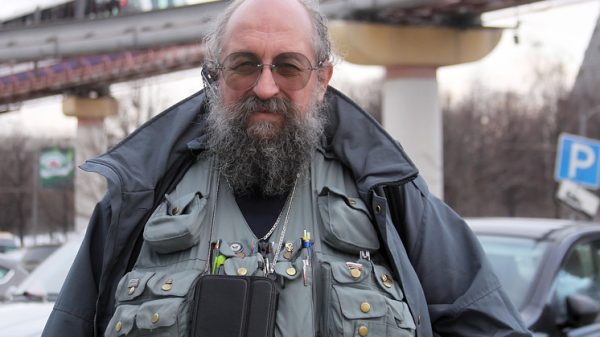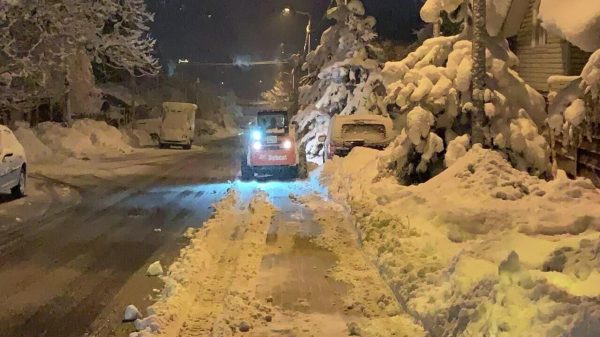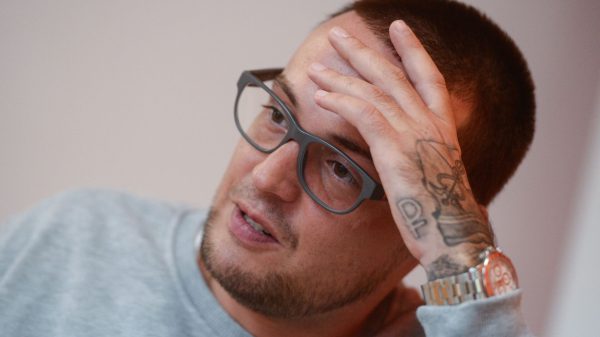As a child in the early 1980s, LeRonne Armstrong spent much of the summer watching cartoons at his grandma’s apartment in west Oakland’s Acorn Projects. The public housing development would later become notorious as the site where Black Panther co-founder Huey Newton was killed in 1989, but for Armstrong’s mother, it was where she sent her three children for safekeeping as crack began menacing the city and violent crime was on the rise.
One morning while Armstrong sat around the TV with his siblings and cousins, Oakland police officers kicked in the door, guns drawn. They had a warrant for Armstrong’s uncle, who was allegedly involved in the drug trade. They pointed their weapons at the children, then proceeded to ransack the home, flipping over furniture and ripping the stuffing from the bottom of couches. Armstrong recalls the officers “going into cabinets and pouring cereal out”.
link box
Even at a young age, Armstrong understood the officers’ actions as an affront to his family’s dignity. “Just to see the manner in which they searched left me in a position where I felt like, man, that’s just messed up,” he said. “Those experiences have a tremendous impact on you growing up and how you view police. It makes you dislike them.”
Armstrong’s distrust was reinforced by his mother, who was wearily accustomed to corrupt policing. She told him, “We don’t talk to the police. We don’t expect the police to do anything for us besides take us to jail or potentially kill us.”
West Oakland at the time was an increasingly dangerous place. “It’s got so that people have been afraid to go out of their houses,” a local Baptist pastor told the New York Times in 1984. And yet, Black residents often viewed the police as a force that terrorized the community it was intended to serve. Caught between the violence of the streets and the violence of the force, some felt they had nowhere to turn.
“My mother actually had an exercise,” Armstrong said. “As soon as you hear the bullets go off, get on the floor and crawl to the back of the house.”
In 1985, Armstrong’s older brother, Andre Gray was fatally shot in the hallways of Oakland technical high School while walking between classes. He was 16 years old, a high school junior, and one of 95 homicides in Oakland that year. In the aftermath, Armstrong, who was 13 at the time, considered taking matters into his own hands to redress the murder. “There was an expectation where I grew up that you retaliate, that you go back and do something on behalf of your family member.”
Armstrong said people offered him weapons, but ultimately he deferred to his mother who urged him not to cause her “more hurt and disappointment”. Within a few days, officers arrested the suspect. For the first time Armstrong allowed the possibility that the police could help keep his community safe.
A question of loyalty: Black or blue?
It’s been 35 years since Gray’s murder, and today Armstrong is a 25-year veteran of law enforcement, and the deputy chief of the Oakland police department. In his office at the Eastmont station, a large sign behind his desk reads “West Oakland” in the signature green of the Oakland A’s. Out of uniform, Armstrong prefers athletic wear. He’s not the hard-nosed seasoned officer one might expect, but rather calm and patient, like an elementary school teacher or youth basketball coach. He’s attentive, takes his time responding to questions, and is not afraid to speak his mind, regardless of how it reflects on his occupation, whose brutality has recently been brought back into sharp focus.
Nationally, police killings have consistently hovered around 1,100 a year since 2013, according to data compiled by Mapping Police Violence – a number that dwarfs other wealthy countries. Although African Americans make up just over 13% of the general population, they account for a disproportionate number of shooting victims and are killed by police at more than twice the rate of white Americans. Police have killed at least one Black man or woman every week in 2020.
According to a recent analysis by the ACLU, Black men face about a 1 in 1,000 chance of being killed by the police over the course of their lives. The report states: “Stunningly, for young men of color, police use of force is now among the leading causes of death.”
Officers of color, especially those who are Black, have at times been met with accusations of selling out their community. During episodes of confrontation between the community and the force, such as this summer’s Black Lives Matter protests, Black officers have to straddle a line of loyalty – Black or blue.
I spoke with Armstrong and other Black Oakland police officers over several weeks at the tail end of this summer about how it feels to be a Black police officer. Our conversations were punctuated by police shootings that have become nauseatingly commonplace – Jacob Blake in Kenosha, Wisconsin; Dijon Kizzee in Los Angeles; Trayford Pellerin in Lafayette, Louisiana – and increasingly urgent calls for police reform.
‘Too street’ to be an officer
Armstrong’s mother wasn’t enamored of his choice to become an officer – she worried about the dangers of being a police officer in the city. Nonetheless, Armstrong told me, “When you come from the hood, your mom is just happy you have a good job.”
She watched her son complete his degree in criminal justice at Sacramento State, and return to Oakland determined to help the most vulnerable members of his city. “With the violence that we experienced in our community, I felt like there should have been somebody there to help keep us safe. Or at least make it livable for families that weren’t involved in violence or gangs.”
He started out as a probation counselor in Alameda county’s youth service division in 1995, working primarily with young Black boys, and joined the Oakland police department three years later. It was not an easy entry. Armstrong said that as a rookie officer, other officers filed anonymous complaints against him, claiming his vehicle had illegally tinted windows and that he wasn’t on the job during his shift. They made comments about him being too friendly with Oakland residents, they called him a weak cop who was more interested in community-based projects such as Midnight Basketball than in making arrests. “People told me that I didn’t belong here, that I was too street.”
Oliver Cunningham, a retired Black lieutenant who served on the Oakland force for nearly 30 years, described similar treatment. “They didn’t trust me,” he said of his fellow officers. “When they would search houses during search warrants, they would, say ‘Hey, you go outside and watch the guy we have detained in the car.’”
Yale sociologist Elijah Anderson, a specialist in urban ethnography, argues this sort of distrust is common. Speaking of Black people, he said, “When you move about in that larger society, in that white space, you have a deficit of credibility. People don’t treat you the same. People approach you with suspicion until you can prove that you’re OK, that you’re not a ‘thug’, that you’re not a ‘hoodlum’, that you are somebody who is trying to be civil and belong.”
Sociologist Rashawn Ray of the Brookings Institution echoes these points. He said that Black officers experience what WEB Du Bois once described as “double consciousness”, a state of seeing oneself through the eyes of other people. “It’s really a feedback loop, which is on one hand [Black officers’] experiences with other police officers and then on the other hand, their experiences with community members.” He suggests that some may feel like impostors for “not really fitting in in either space”.
Former lieutenant Cunningham said Black officers are commonly stigmatized as sellouts by the Black community, particularly if they police the same areas they come from. Some of his Black colleagues, he said, have arrested people they went to high school with, and then “had threats on their life”.
The pressures for Black officers to assimilate within the professional culture extend beyond race to masculinity itself, and the climate of machismo that pervades police work. Frank Rudy Cooper, a lawyer who studies race, gender and policing, argues that police culture has a masculinity problem. He views the recourse to violence as a “tendency of masculine behavior” and one that becomes amplified by racial dynamics. “Young men of color are the boogeyman. They are the personification of danger in the eyes of much of the public and the police,” he wrote in 2016. “Police officers may be both seeking to maintain their place in the male pecking order and genuinely afraid of men of color.”
In our conversation, Cooper expands, “Masculinity has race embedded in it.” In the US, he said, the dominant conception of masculinity places white men at the top. To maintain their place in the hierarchy requires “denigrating men who don’t live up to the standard of masculinity, [and] dominating racial minority men, especially Black men”.
Jeffrey Loman, a retired officer, said these attitudes were evident during his 29 years patrolling the streets. “A lot of [officers] came here for the money, they came for the excitement. And then they don’t look at it as their community. They feel like they’re coming out here to restore order to this lawless place,” he tells me. “They say, ‘Who are you to question my authority or tell me I’m right or wrong?’ They find a reason to detain you, handcuff you, place you in the back of the car, even arrest you. And if they needed to use force, they were not shy about using force.”
The inherent machismo of blue culture
President Obama’s Task Force on 21st Century Policing, established in 2014, recommended that to reduce police violence and improve relations with minority communities, police departments should increase officer demographic diversity – along with raising educational requirements for new officers, and implementing community policing strategies. The call for diversity has been widely embraced by policy experts and activists alike, and has been supported by research. A widely touted 2016 study published in Public Administration Review, for instance, found that an increase in the proportion of ethnic minority officers is strongly associated with a decrease in police misconduct.
However, other recent analyses suggest that curbing excessive force may not be so straightforward. Kayla Prieto Hodge is a sociologist at Rutgers who has studied Black officers who serve in Black communities in the north-east. She is critical of the proposition that increasing police racial diversity will improve social justice outcomes.
In her research she has found that Black officers are socialized into “blue organizational culture”, which is often based on hierarchical, racist and sexist values, and that even officers who joined the force because they wanted to “change the face of policing” or to help their communities were still commonly co-opted by the prevailing attitudes of their departments. “Blue”, in her research refers to “a machismo culture, a way of life, an us versus them mentality, white supremacist ideology, and belief in law and order”.
While she maintains that officer diversity is important in terms of representation, it is not the solution to “fixing the deep-seated issues that have been present in police departments across the country since their inception.” Diversity, she said, is a “Band-Aid” over the inherent violence of police work; it merely changes the profile of who is committing the violence.
Peter Moskos, a sociologist and former police officer, spent a year embedded with the Baltimore City police and observed that both Black and white officers tend to espouse socially conservative beliefs and to circulate negative stereotypes about the African American neighborhoods they patrol. While white officers tend to offer unambiguously negative descriptions of these neighborhoods, Black officers more frequently underscore the class struggle between “decent” working people and harmful “street” culture.
“Black police are more likely to see their role as ‘peacekeepers ,protecting the ‘good people’ in the ghetto,” he writes. “White police officers see the ‘ghetto’ more as a miasma that pollutes all in its midst.”
The Black officers I spoke with were keenly aware of serving in a profession that disproportionately incarcerates and kills other Black people, and shared that their roles required walking a fine line between being Black men and being “blue” officers, balancing outrage and community affiliation with a sense of professional duty. When I asked retired Captain Freddie Hamilton Captain Hamilton – who joined the department in 1990 at age 23 to be a “protector” and “peacemaker” – his thoughts on the 2009 shooting of Oscar Grant by Bart police in Oakland, or the current protests against police violence, he replied, it’s problematic “in that a large part of my colleagues just dismiss it”.
Armstrong expands: “Clearly I’m angry about the things that I see and I’m terribly disappointed by the actions of some police officers in this country. It’s obviously something that is disgusting to me.”
But Armstrong doesn’t consider himself to be one of those “bastard cops” of public indignation and believes his experiences as a Black man from west Oakland make him better at his job.
Despite having to pull the mental double duty, many of the officers I interviewed cited their race as an advantage. They maintained that as Black men, they are better able to understand the social circumstances of Black communities and the ways racism pervades the criminal justice system – more often than not, they had experienced disparate treatment first-hand.
Retired officer Mark Hicks tells me that as a Black man, “I had to do police work differently.”
Hicks grew up in an upper-middle-class neighborhood in Oakland, where his father was a dentist and his family was well-known. As a youth, he and his friends used to play around a nearby housing development site. One day, an officer showed up and grabbed him and his friends, questioned them about what they were doing, and accused them of stealing from the developing homes. They were eventually let go, but the episode lingers in his mind as an example of how not to police. He said, “I didn’t have to be the letter of the law. If a person is drunk, I didn’t have to arrest them. I’ve known this person since I was a little boy. So I’m taking this person home.”
Retired officer Loman shared a similar experience. As a teenager on his way home from school, Oakland officers stopped him for no reason other than walking while black. “I was terrified,” he recalls. “They threw me up against the car, searched me, and I didn’t know my rights. I didn’t know what I could do.” That encounter led to a pronounced dislike of the police.
However, years later, he met a group of Black officers, who were approachable and respectful in their dealings with the community, and his perspective changed. “It sounds cliche, but I really wanted to help people,” he said. Loman said he also used his discretion in policing. “Being Black and coming from Oakland, a bunch of times I’ve pulled over people that I knew and I always took it as an opportunity to educate them rather than give them a ticket. I didn’t just tell them, I’m giving you a break. I tell them why what they were engaged in was dangerous.”
‘I’m a Black man first’
As deputy chief, Armstrong is the highest-ranking officer in Oakland’s Eastmont precinct. In February 2020, the Oakland Police Commission fired chief Anne Kirkpatrick after three years on the job. When she joined the department in 2017, she was the fourth top officer to assume the role in a span of seven months and inherited a force that was mired in a sex abuse scandal involving a teenage girl that had cost the prior three chiefs their jobs.
Armstrong is now being considered for the role of Oakland’s next chief of police. If appointed, he would oversee one of the most controversy-ridden departments in the country.
Shortly after Armstrong became an Oakland officer, claims of gross misconduct rocked the department. In 2000, 119 plaintiffs – the vast majority of whom were people of color – alleged that four veteran officers known as the “Rough Riders” had over the previous four years made false arrests, planted evidence and used excessive force. The city settled with the plaintiffs for $10.9m and in 2003 signed a negotiated settlement agreement that required the department to make major changes to uphold its commitment to constitutional policing. An independent monitor stepped in to oversee 51 specific civil rights reforms, including eliminating racial profiling and curbing police shootings. Their oversight was supposed to have lasted five years, but continues to this day.
Since 2003, the city of Oakland has cycled through 12 police chiefs, six of whom were either interim chiefs, acting chiefs or city administrators, and none of whom have been able to help the department fully overcome its reputation for dysfunction or allay the public’s crisis of confidence.
There are many theories as to why this has been the case, including a “toxic, macho” occupational culture (in the words of Mayor Libby Schaaf), endemic racism within the ranks, the fact that just 10% of officers actually live in the city, and the pronounced gap between the racial makeup of the force and the community it serves: while the department patrols a city that is roughly 24% Black and 36% white, Black officers make up only about 16.5% of the force, which is 35% white. Thelton Henderson, a retired federal judge who presided over the negotiated settlement agreement until 2017 takes a dim view of the department’s continued inability to reform.
“I’m firmly convinced it hasn’t happened because they don’t want it to happen,” he told me. The president of the police commission, Regina Jackson, said that new leadership is needed for Oakland to end police violence. “You actually have to do things differently.” She said Oakland needs a chief “who has the emotional intelligence to recognize that the most disenfranchised is the strongest partner”.
Armstrong believes he can meet the challenges of the role. As a Black man, he said, “I know what it’s like.
“People have locked their doors when they see me walk next to their car with the assumption that I was about to do something. I have seen women switch purses to other arms when they walk beside me. I’ve also been pulled over by police who didn’t know I was a cop,” he said.
For his part, Armstrong rejects the pressures to assimilate. “I’m a Black man first,” he said. “I should be able to bring who I am and my culture to this profession.” He knows all too well the traumas his peers have inflicted on his community. And yet, he believes that as a member of the police he can provide his community with the safety, justice and respect that he longed for growing up.
“I know why I do this job. I come here every day with a pure heart and with the idea that I can do something to help.”
-
Akintunde Ahmad is a multimedia journalist based in Oakland, California. He is currently an Ida B Wells Fellow with Type Investigations




















































Свежие комментарии